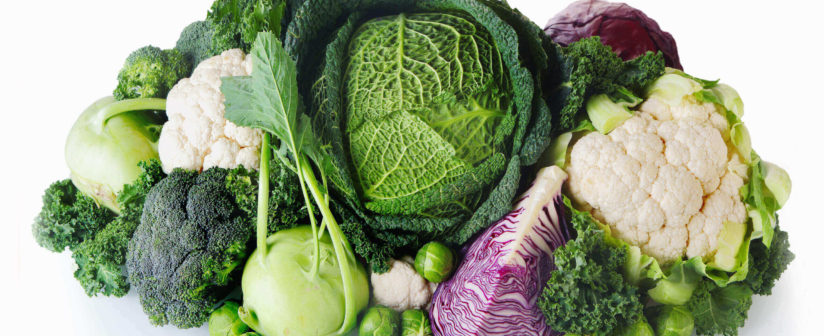Everyone knows that eating vegetables has profound health benefits. But, like all foods, not all vegetables are created the same. Some are better than others in terms of nutritional content, and overall contribution to vibrant health. If you look more closely at their phytochemical [plant-based chemical] content, or the growing amount of research into their specific effects on the body and disease, a few vegetables appear to be downright “miracle” foods!
What are cruciferous vegetables?
Cruciferous vegetables have it all: vitamins, fiber, and disease-fighting phytochemicals.
Broadly, cruciferous vegetables belong to the Cruciferae family, which mostly contains the Brassica genus, but does include a few other genuses. In general, cruciferous vegetables are cool weather vegetables and have flowers that have four petals so that they resemble a cross.
Complete List of Cruciferous Vegetables
Below you will find a list of cruciferous vegetables. While you may not have heard the term cruciferous vegetable before, it’s likely that you have grown many of them in your garden. They include:
- Arugula
- Bok choi
- Broccoli
- Broccoli rabe
- Broccoli romanesco
- Brussels sprout
- Cabbage
- Cauliflower
- Chinese broccoli
- Chinese cabbage
- Collard greens
- Daikon
- Garden cress
- Horseradish
- Kale
- Kohlrabi
- Komatsuna
- Land cress
- Mizuna
- Mustard – seeds and leaves
- Pak choi
- Radish
- Rutabaga
- Tatsoi
- Turnips – root and greens
- Wasabi
- Watercress
With that in mind, here are the top ten reasons to eat your cruciferous vegetables.
- Anti-Cancer Benefits
Sulforaphane is increasingly referred to as an anticancer compound. This reputuation is linked mainly to sulforaphane’s potent antioxidant and antiflammatory properties, not dissimilar to turmeric (curcumin). In fact, one promising, albeit preclinical study found that the combination of sulforaphane, aspirin and curcumin was effective for the chemoprevention of pancreatic cancer.
It doesn’t stop there, however. Sulforaphane has been studied for the prevention and treatment of several types of cancer, including stomach, bladder, breast, prostate, lung, colon and skin.
- Depression Relief
Cruciferous and sulforaphane may also have significant benefit for depression. An animal study published in 2015 found sulforaphane “has antidepressant and anxiolytic-like [anxiety reducing] activities in stressed mice model of depression, which likely occurs by inhibiting the hypothalamic.” Inflammation has also been connected to depression, and a 2016 study found broccoli sprouts effective to “prevent or minimize the relapse by inflammation.”
- Pain Relief
This is some evidence that sulforaphane may have significant value in pain, or pain management. A 2000 study on female fibromyalgia patients reported that the combination of ascorbigen (derived from Vitamin C) and broccoli powder “reduces pain sensitivity and improves quality of life” for patients suffering from this challenging condition.
- Cardioprotection
Cardiovascular problems remain a top health concern, especially in the United States. CVD, cardiovascular disease, is on the rise, with Ischemia-Reperfusion (I/R) injury (such as myocardial infarction (“heart attack”), stroke, and peripheral vascular disease) and hypertension being main components.
Research is showing that sulforaphane helps with inflammation of the arterial walls, inhibits obesity, relieves hypertension, and other conditions that are part of or lead to CVD.
- Antioxidants
It’s well known that cruciferous, especially broccoli, is a superior source of antioxidants. There are almost 300 studies on PubMed alone, referring to these vegetables and antioxidants.
- Protection From and Elimination of Toxins
Studies have also shown sulforaphane assists in protection from and elimination of arsenic and pesticides. The detoxifying qualities of cruciferous is thought to be directly connected to sulforaphane’s role in activation of Nrf2, which is known to have a critical role in the metabolism and excretion of toxic substances.
- Type II Diabetes and Insulin Resistance (IR) Support
It’s generally recognized that diet and exercise can profoundly assist with the prevention and treatment of Type II Diabetes. However, specific positive results have been seen with regard to sulforaphane and consuming cruciferous vegetables.
- Helicobacter pylori Support
The bacteria Helicobacter pylori is most famously associated with stomach ulcers, and, in many cases, gastric cancer. Our sulforaphane-laden cruciferous friends happen to offer distinct support in eliminating the colonization of this organism in our bodies.
- Alzheimer’s Applications
Studies suggest that sulforaphane might be a promising therapeutic agent for cognitive enhancement in Alzheimer’s disease. They reported positive effects against the measures of two major factors implicated in the pathogenesis of AD, as well as upregulation in the intracellular glutathione content and the activity of antioxidant enzymes — both of which may contribute to improved tissue detoxification and function.
- Anti-Inflammatory Benefits
Dysfunctional inflammation has increasingly become identified to be a driving factor at the root of most, if not all, chronic illness and disease. In some form or another, somewhere, a body that is unwell, is inflamed. Luckily, nature has provided us with several remedies for this scourge of our times.


